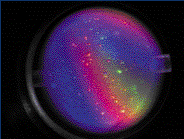Brent D. Johnson, Senior News Editor
Colloid engineering is the concept that crystallized structures based on colloidal self-assembly can be made into tools. Materials that have a mixture of small, optically inert spheres combined with liquid crystals can be used as optical filters or optical switches.

While testing the color imaging cameras on the Physics of Colloids in Space hardware, Harvard University researchers acquired this image of AB6 crystals, which had formed in a binary alloy colloidal suspension. The crystals are illuminated with white light. Different regions of the sample cell Bragg-scatter different wavelengths of the illumination, resulting in the colored regions. The bright spots are large crystallites oriented so that their strong Bragg scattering is directed at the camera. The field of view is approximately 1.8 cm.
"Imagine a liquid crystal that has hollow spheres," said Mike Doherty, a project manager in the NASA Glenn Research Center's Microgravity Science Div. "You could change the optical throughput properties of the material."
In microgravity, crystals form a periodic spacing that can result in a three-dimensional constructive/destructive Bragg grating. "If we can dial up the properties by index of refraction, we can make binary colloidal alloys," he said. "You would have nanoscale structures that are tailored to light."
To produce tailored structures, physicists need to understand more about how the crystals develop. Doherty has eight experiments on the International Space Station. Proposed by condensed-matter physicist David Weitz of Harvard University in Cambridge, Mass., the Physics of Colloids in Space experiment took off April 19 on the space shuttle Endeavour. It will take about 2000 hours over the next 12 months, in scheduled four- to 48-hour time blocks, to complete.
The experiment uses low- and high-angle cameras and an avalanche photodiode. The high-angle camera is a PMI 1401 from Quantitative Imaging Corp., formerly known as the Xillix MicroImager Model MI 1,400-12X.
The system captures snapshots of crystals as they develop. It will eventually build an overlay of how they grow. Doherty describes the apparatus as a light-scattering instrument. Light is Bragg-scattered from the colloid samples onto a fluorescent screen, where the PMI high-angle camera collects the image.
One reason for Doherty's camera selection was its heritage. He flew one on a Spacelab mission in July 1997 on the STS 94 space shuttle. It was used in the Microgravity Science Laboratory 1 Physics of Hard Spheres Experiment.
His reasons for choosing the camera have not changed much today: "High resolution, good stability, good pixel array size and shape, and a high dynamic range."